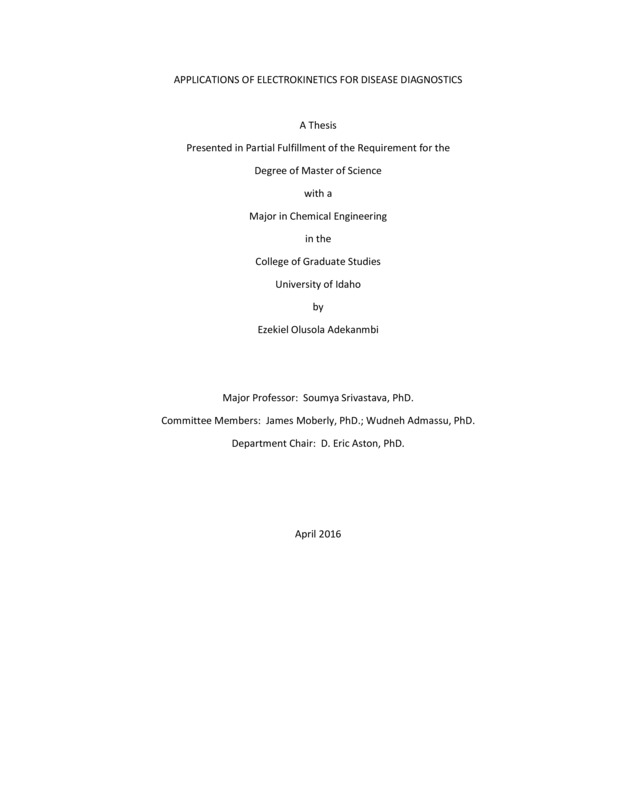APPLICATIONS OF ELECTROKINETICS FOR DISEASE DIAGNOSTICS
Adekanmbi, Ezekiel Olusola. (2016). APPLICATIONS OF ELECTROKINETICS FOR DISEASE DIAGNOSTICS. Theses and Dissertations Collection, University of Idaho Library Digital Collections. https://www.lib.uidaho.edu/digital/etd/items/adekanmbi_idaho_0089n_10902.html
- Title:
- APPLICATIONS OF ELECTROKINETICS FOR DISEASE DIAGNOSTICS
- Author:
- Adekanmbi, Ezekiel Olusola
- Date:
- 2016
- Embargo Remove Date:
- 2016-12-02
- Keywords:
- Babesiosis Diagnostics Dielectrophoresis Microdevice Microfluidics
- Program:
- Chemical and Materials Science Engineering
- Subject Category:
- Chemical engineering; Biomedical engineering
- Abstract:
-
Disease diagnostics is an important subset of medical diagnosis. Before the advent of microfluidics, diagnostic activities were largely in specified, confined spaces and often require large sample volumes. They also require substantial time-frame to generate results and the probability of human errors is considerably high. Miniaturizing these diagnostic components solves the aforementioned problems and thus improve the entire diagnostic process. A viable electro-kinetic technique employed in microfluidic devices is insulator-based dielectrophoresis. Dielectrophoresis has been used to manipulate various diseases cells. Applications of this technique are reported here for malaria, human African trypanosomiasis, dengue, anthrax, and myraids of cancerous conditions. This same technique was utilized to sort and concentrate red blood cells infected with Babesia pathogen: the intra-erythrocytic apicomplexan etiologic agent for the dreaded disease called Babesiosis. The separation of infected red blood cells from their homogeneous mixture with healthy red blood cells requires both numerical and experimental commitments. In the numerical analysis, no cell separation was observed below and above the operating voltage of 6.2V. This numerical value compares favorably with the experimental operating voltage, which was found to be 6.0V. Validation of the dielectrophoretic separation was carried out in two phases: microscopy and numerical quantifications. Both fluorescence and bright-field microscopic examinations underscore the separation. Quantitative analysis revealed the micro-device’s capability to concentrate infected red blood cells from an average of 7% to 70%. These results represent the first step needed in building a portable, accurate, quick and easy-to-use diagnostic device for Babesiosis. The pathogen can also be extracted from the concentrated cells and attenuated for preliminary works on Babesiosis vaccine formulation.
- Description:
- masters, M.S., Chemical and Materials Science Engineering -- University of Idaho - College of Graduate Studies, 2016
- Major Professor:
- Srivastava, Soumya K
- Committee:
- Moberly, James; Admassu, Wudneh
- Defense Date:
- 2016
- Identifier:
- Adekanmbi_idaho_0089N_10902
- Type:
- Text
- Format Original:
- Format:
- application/pdf
- Rights:
- In Copyright - Educational Use Permitted. For more information, please contact University of Idaho Library Special Collections and Archives Department at libspec@uidaho.edu.
- Standardized Rights:
- http://rightsstatements.org/vocab/InC-EDU/1.0/

